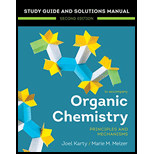
Concept explainers
(a)
Interpretation:
The MO resulting from the given orbital interaction is to be drawn.
Concept introduction:
When atomic orbitals (AOs) of the same phase interact, they result in a bonding molecular orbital (MO) that is lower in energy than the individual AOs.
Answer to Problem 3.1P
The MO resulting from the given orbital interaction can be drawn as follows:

Explanation of Solution
The orbital interaction shows two orbitals that are lightly shaded. Both have the same negative phase. Since the phases of both are the same, there will be constructive interference, resulting in a bonding MO of negative phase.
The MO resulting from the given orbital interaction can be drawn as follows:

The interaction between orbitals of the same phase results in the formation of a bonding MO.
(b)
Interpretation:
Whether the resulting MO is unique compared to the one shown on the right of Figure 3-6a is to be determined.
Concept introduction:
When atomic orbitals (AOs) of the same phase interact, the resulting molecular orbital (MO) has a lower energy than the separate AOs. The phases of the interacting orbitals may be both positive or both negative. The resulting stabilization (lowering of energy) is the same for both.
Answer to Problem 3.1P
The MO resulting from the interaction shown will not be unique compared to the one shown in Figure 3-6a.
Explanation of Solution
The interaction in this case is between AOs of negative phases (light shading). Since the phases are the same, the interaction will result in constructive interference, increasing the electron density between the two nuclei. This will lower the energy of the MO compared to the individual AOs. The extent to which the energy is lowered will be the same as in case of the interaction shown in Figure 3-6a. This is because the interacting orbitals are same except for a different phase.
Therefore, the MO resulting from the interaction shown will not be unique compared to the one in Figure 3-6a.
The interaction between AOs of same phase results in a bonding MO with the same stabilization, whether their phases are both positive or both negative.
Want to see more full solutions like this?
Chapter 3 Solutions
EBK ORGANIC CHEMISTRY: PRINCIPLES AND M
- I need help with the followingarrow_forwardFor Raman spectroscopy/imaging, which statement is not true regarding its disadvantages? a) Limited spatial resolution. b) Short integration time. c) A one-dimensional technique. d) Weak signal, only 1 in 108 incident photons is Raman scattered. e) Fluorescence interference.arrow_forwardUsing a cell of known pathlength b = 1.25115 x 10-3 cm, a water absorption spectrum was measured. The band at 1645 cm-1, assigned to the O-H bending, showed an absorbance, A, of 1.40. a) Assuming that water density is 1.00 g/mL, calculate the water molar concentration c (hint: M= mole/L) b) Calculate the molar absorptivity, a, of the 1645 cm-1 band c) The transmitted light, I, can be written as I= Ioexp(-xb), where x is the absorption coefficient (sometimes designated as alpha), Io is the input light, and b is the cell pathlength. Prove that x= (ln10)*x*c. (Please provide a full derivation of the equation for x from the equation for I). d) Calculate x for the 1645 cm-1 bandarrow_forward
- For CARS, which statement is not true regarding its advantages? a) Contrast signal based on vibrational characteristics, no need for fluorescent tagging. b) Stronger signals than spontaneous Raman. c) Suffers from fluorescence interference, because CARS signal is at high frequency. d) Faster, more efficient imaging for real-time analysis. e) Higher resolution than spontaneous Raman microscopy.arrow_forwardDraw the major product of the Claisen condensation reaction between two molecules of this ester. Ignore inorganic byproducts. Incorrect, 5 attempts remaining 1. NaOCH3/CH3OH 2. Acidic workup Select to Draw O Incorrect, 5 attempts remaining The total number of carbons in the parent chain is incorrect. Review the reaction conditions including starting materials and/or intermediate structures and recount the number of carbon atoms in the parent chain of your structure. OKarrow_forwardUsing a cell of known pathlength b = 1.25115 x 10-3 cm, a water absorption spectrum was measured. The band at 1645 cm-1, assigned to the O-H bending, showed an absorbance, A, of 1.40. a) Assuming that water density is 1.00 g/mL, calculate the water molar concentration c (hint: M= mole/L) b) Calculate the molar absorptivity, a, of the 1645 cm-1 band c) The transmitted light, I, can be written as I= Ioexp(-xb), where x is the absorption coefficient (sometimes designated as alpha), Io is the input light, and b is the cell pathlength. Prove that x= (ln10)*x*c d) Calculate x for the 1645 cm-1 bandarrow_forward
 Organic Chemistry: A Guided InquiryChemistryISBN:9780618974122Author:Andrei StraumanisPublisher:Cengage Learning
Organic Chemistry: A Guided InquiryChemistryISBN:9780618974122Author:Andrei StraumanisPublisher:Cengage Learning
